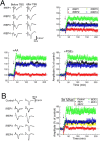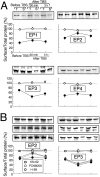Bidirectional trafficking of prostaglandin E2 receptors involved in long-term potentiation in visual cortex
- PMID: 17021176
- PMCID: PMC6674642
- DOI: 10.1523/JNEUROSCI.3028-06.2006
Bidirectional trafficking of prostaglandin E2 receptors involved in long-term potentiation in visual cortex
Abstract
Although prostaglandin E2 (PGE2) has a broad spectrum of biological activities that have been confirmed by previous studies, the roles of PGE2 in synaptic plasticity such as long-term potentiation (LTP) in the CNS have yet to be characterized in detail. The present results of electrophysiological and biochemical studies indicated that PGE2 is actually produced in acute visual cortex slices in response to theta-burst stimulation (TBS) and is involved postsynaptically in TBS-induced LTP. RNA interference (RNAi) for PGE2 receptor subtypes EP2 and EP3, which are known to upregulate and downregulate the level of cAMP, respectively, induced significant decreases and increases of LTP, respectively. Moreover, analysis of the localization of receptor subtypes at the membrane surface or cytosol showed that stimuli such as TBS regulate the trafficking of EP2 and EP3 between the membrane and cytosol of the postsynapses, rising up to and leaving the membrane, respectively, resulting in increased and decreased expression of EP2 and EP3 at the membrane, respectively. Increased activation of EP2 and decreased activation of EP3 by PGE2 synergistically induce an increase in cAMP level, which may induce LTP. This causes activation of CREB (cAMP response element-binding protein) in the postsynaptic cells, which may be involved in the maintenance of LTP. These observations indicate that in TBS-induced LTP of the visual cortex, PGE2 is released from the postsynaptic cells and then activates PGE2 receptors at the postsynaptic membranes, which is regulated by trafficking of the differential PGE2 receptor subtypes in an activity-dependent bidirectional manner.
Figures









Similar articles
-
Role of EP2 receptors and cAMP in prostaglandin E2 regulated expression of type I collagen alpha1, lysyl oxidase, and cyclooxygenase-1 genes in human embryo lung fibroblasts.J Cell Biochem. 1998 Nov 1;71(2):254-63. J Cell Biochem. 1998. PMID: 9779823
-
[Cooperation of two subtypes of PGE2 receptor, Gi coupled EP3 and Gs coupled EP2 or EP4 subtype].Yakugaku Zasshi. 2003 Oct;123(10):837-43. doi: 10.1248/yakushi.123.837. Yakugaku Zasshi. 2003. PMID: 14577329 Review. Japanese.
-
Temporal and tissue-specific expression of prostaglandin receptors EP2, EP3, EP4, FP, and cyclooxygenases 1 and 2 in uterus and fetal membranes during bovine pregnancy.Endocrinology. 2004 Jan;145(1):407-17. doi: 10.1210/en.2003-1007. Epub 2003 Sep 18. Endocrinology. 2004. PMID: 14500566
-
EP4/EP2 receptor-specific prostaglandin E2 regulation of interleukin-6 generation by human HSB.2 early T cells.J Pharmacol Exp Ther. 1998 Sep;286(3):1420-6. J Pharmacol Exp Ther. 1998. PMID: 9732406
-
Evaluation of selective prostaglandin E2 (PGE2) receptor agonists as therapeutic agents for the treatment of asthma.Sci STKE. 2005 Sep 27;2005(303):pe47. doi: 10.1126/stke.3032005pe47. Sci STKE. 2005. PMID: 16189372 Review.
Cited by
-
Δ9-THC-caused synaptic and memory impairments are mediated through COX-2 signaling.Cell. 2013 Nov 21;155(5):1154-1165. doi: 10.1016/j.cell.2013.10.042. Cell. 2013. PMID: 24267894 Free PMC article.
-
Lipid signaling in cytosolic phospholipase A2alpha-cyclooxygenase-2 cascade mediates cerebellar long-term depression and motor learning.Proc Natl Acad Sci U S A. 2010 Feb 16;107(7):3198-203. doi: 10.1073/pnas.0915020107. Epub 2010 Jan 28. Proc Natl Acad Sci U S A. 2010. PMID: 20133605 Free PMC article.
-
Differential effects of treadmill exercise on cyclooxygenase-2 in the rat hippocampus at early and chronic stages of diabetes.Lab Anim Res. 2011 Sep;27(3):189-95. doi: 10.5625/lar.2011.27.3.189. Epub 2011 Sep 30. Lab Anim Res. 2011. PMID: 21998607 Free PMC article.
-
Dissection method affects electrophysiological properties of hippocampal slices.Oruen. 2017 Dec;3(2):94-101. Oruen. 2017. PMID: 30556063 Free PMC article.
-
Impaired cognition, sensorimotor gating, and hippocampal long-term depression in mice lacking the prostaglandin E2 EP2 receptor.Exp Neurol. 2009 May;217(1):63-73. doi: 10.1016/j.expneurol.2009.01.016. Epub 2009 Feb 3. Exp Neurol. 2009. PMID: 19416671 Free PMC article.
References
-
- Abel T, Nguyen PV, Barad M, Deuel TA, Kandel ER, Bourtchouladze R. Genetic demonstration of a role for PKA in the late phase of LTP and in hippocampus-based long-term memory. Cell. 1997;88:615–626. - PubMed
-
- Adesnik H, Nicoll RA, England PM. Photoinactivation of native AMPA receptors reveals their real-time trafficking. Neuron. 2005;48:977–985. - PubMed
-
- Akaneya A, Jiang B, Tsumoto T. RNAi-induced gene silencing by local electroporation in targeting brain region. J Neurophysiol. 2005;93:594–602. - PubMed
Publication types
MeSH terms
Substances
LinkOut - more resources
Full Text Sources
Other Literature Sources
Research Materials
